JEEP PATRIOT 2019 Owner handbook (in English)
Manufacturer: JEEP, Model Year: 2019, Model line: PATRIOT, Model: JEEP PATRIOT 2019Pages: 332, PDF Size: 1.99 MB
Page 231 of 332
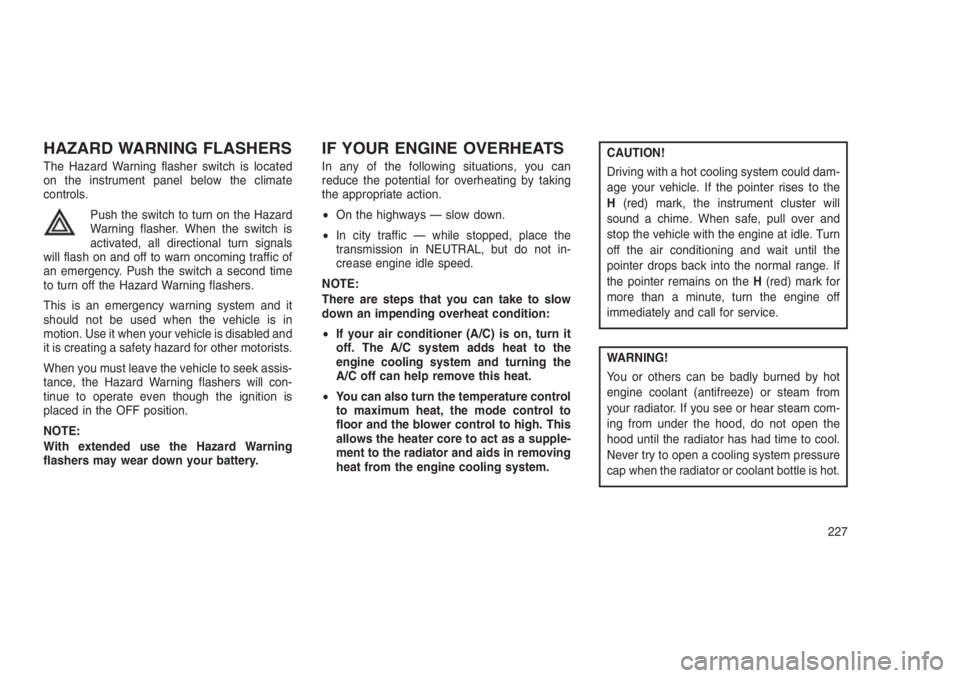
HAZARD WARNING FLASHERS
The Hazard Warning flasher switch is located
on the instrument panel below the climate
controls.
Push the switch to turn on the Hazard
Warning flasher. When the switch is
activated, all directional turn signals
will flash on and off to warn oncoming traffic of
an emergency. Push the switch a second time
to turn off the Hazard Warning flashers.
This is an emergency warning system and it
should not be used when the vehicle is in
motion. Use it when your vehicle is disabled and
it is creating a safety hazard for other motorists.
When you must leave the vehicle to seek assis-
tance, the Hazard Warning flashers will con-
tinue to operate even though the ignition is
placed in the OFF position.
NOTE:
With extended use the Hazard Warning
flashers may wear down your battery.
IF YOUR ENGINE OVERHEATS
In any of the following situations, you can
reduce the potential for overheating by taking
the appropriate action.
•On the highways — slow down.
•In city traffic — while stopped, place the
transmission in NEUTRAL, but do not in-
crease engine idle speed.
NOTE:
There are steps that you can take to slow
down an impending overheat condition:
•If your air conditioner (A/C) is on, turn it
off. The A/C system adds heat to the
engine cooling system and turning the
A/C off can help remove this heat.
•You can also turn the temperature control
to maximum heat, the mode control to
floor and the blower control to high. This
allows the heater core to act as a supple-
ment to the radiator and aids in removing
heat from the engine cooling system.CAUTION!
Driving with a hot cooling system could dam-
age your vehicle. If the pointer rises to the
H(red) mark, the instrument cluster will
sound a chime. When safe, pull over and
stop the vehicle with the engine at idle. Turn
off the air conditioning and wait until the
pointer drops back into the normal range. If
the pointer remains on theH(red) mark for
more than a minute, turn the engine off
immediately and call for service.
WARNING!
You or others can be badly burned by hot
engine coolant (antifreeze) or steam from
your radiator. If you see or hear steam com-
ing from under the hood, do not open the
hood until the radiator has had time to cool.
Never try to open a cooling system pressure
cap when the radiator or coolant bottle is hot.
227
Page 232 of 332
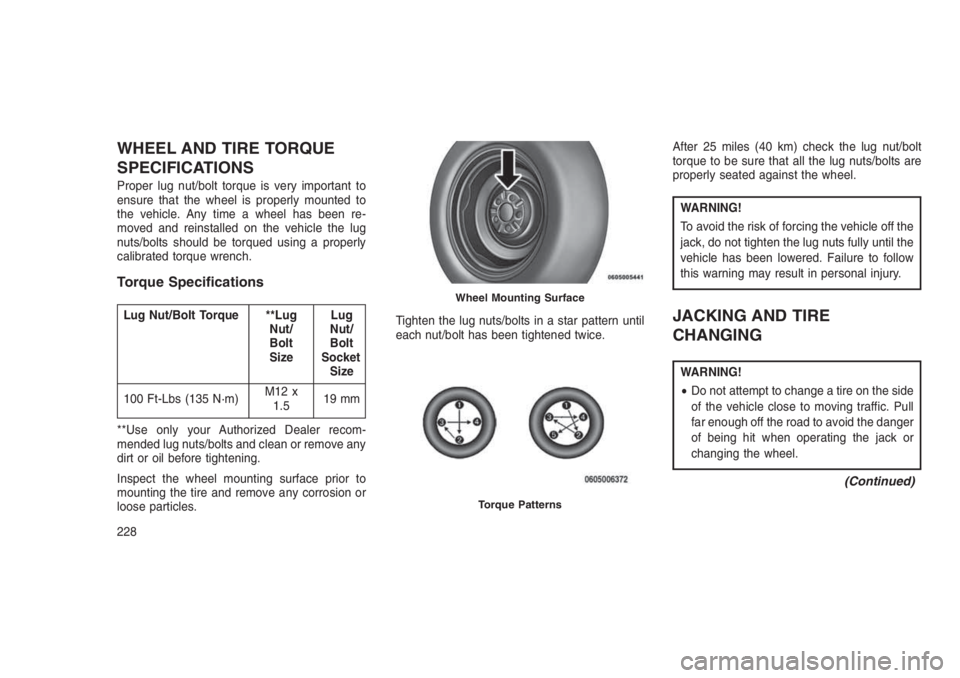
WHEEL AND TIRE TORQUE
SPECIFICATIONS
Proper lug nut/bolt torque is very important to
ensure that the wheel is properly mounted to
the vehicle. Any time a wheel has been re-
moved and reinstalled on the vehicle the lug
nuts/bolts should be torqued using a properly
calibrated torque wrench.
Torque Specifications
Lug Nut/Bolt Torque **Lug
Nut/
Bolt
SizeLug
Nut/
Bolt
Socket
Size
100 Ft-Lbs (135 N·m)M12 x
1.519 mm
**Use only your Authorized Dealer recom-
mended lug nuts/bolts and clean or remove any
dirt or oil before tightening.
Inspect the wheel mounting surface prior to
mounting the tire and remove any corrosion or
loose particles.Tighten the lug nuts/bolts in a star pattern until
each nut/bolt has been tightened twice.After 25 miles (40 km) check the lug nut/bolt
torque to be sure that all the lug nuts/bolts are
properly seated against the wheel.
WARNING!
To avoid the risk of forcing the vehicle off the
jack, do not tighten the lug nuts fully until the
vehicle has been lowered. Failure to follow
this warning may result in personal injury.
JACKING AND TIRE
CHANGING
WARNING!
•Do not attempt to change a tire on the side
of the vehicle close to moving traffic. Pull
far enough off the road to avoid the danger
of being hit when operating the jack or
changing the wheel.
(Continued)
Wheel Mounting Surface
Torque Patterns
228
Page 233 of 332
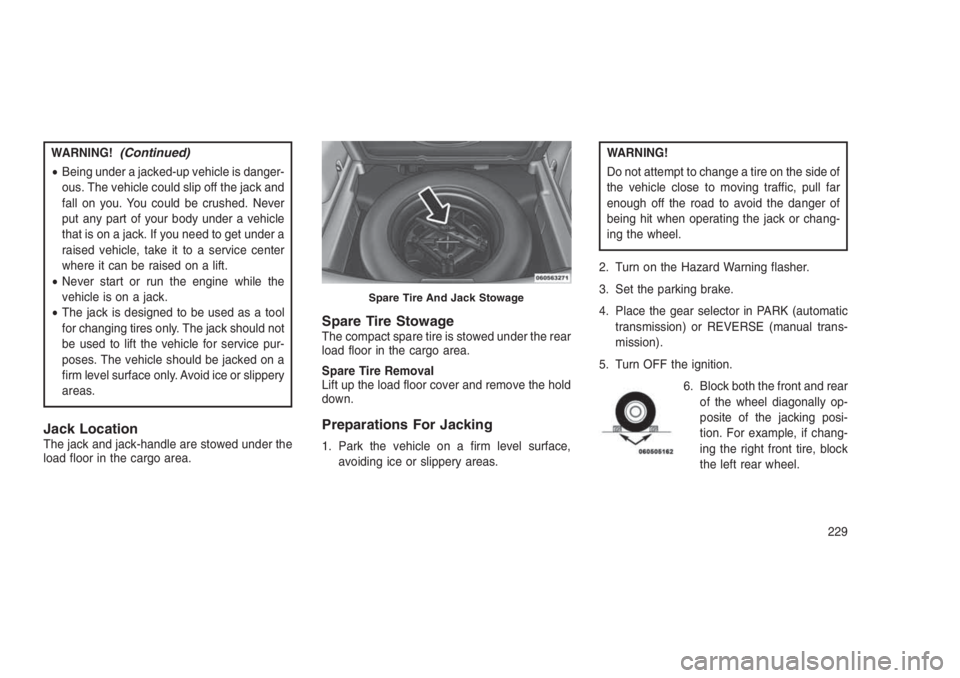
WARNING!(Continued)
•Being under a jacked-up vehicle is danger-
ous. The vehicle could slip off the jack and
fall on you. You could be crushed. Never
put any part of your body under a vehicle
that is on a jack. If you need to get under a
raised vehicle, take it to a service center
where it can be raised on a lift.
•Never start or run the engine while the
vehicle is on a jack.
•The jack is designed to be used as a tool
for changing tires only. The jack should not
be used to lift the vehicle for service pur-
poses. The vehicle should be jacked on a
firm level surface only. Avoid ice or slippery
areas.
Jack LocationThe jack and jack-handle are stowed under the
load floor in the cargo area.
Spare Tire StowageThe compact spare tire is stowed under the rear
load floor in the cargo area.
Spare Tire Removal
Lift up the load floor cover and remove the hold
down.
Preparations For Jacking
1. Park the vehicle on a firm level surface,
avoiding ice or slippery areas.
WARNING!
Do not attempt to change a tire on the side of
the vehicle close to moving traffic, pull far
enough off the road to avoid the danger of
being hit when operating the jack or chang-
ing the wheel.
2. Turn on the Hazard Warning flasher.
3. Set the parking brake.
4. Place the gear selector in PARK (automatic
transmission) or REVERSE (manual trans-
mission).
5. Turn OFF the ignition.
6. Block both the front and rear
of the wheel diagonally op-
posite of the jacking posi-
tion. For example, if chang-
ing the right front tire, block
the left rear wheel.
Spare Tire And Jack Stowage
229
Page 234 of 332
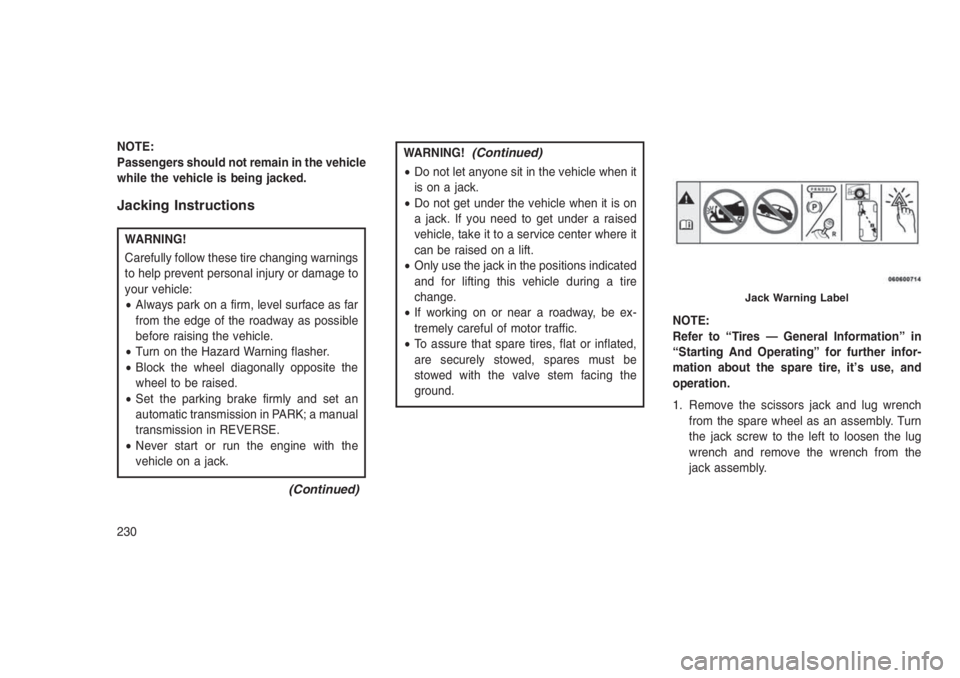
NOTE:
Passengers should not remain in the vehicle
while the vehicle is being jacked.
Jacking Instructions
WARNING!
Carefully follow these tire changing warnings
to help prevent personal injury or damage to
your vehicle:
•Always park on a firm, level surface as far
from the edge of the roadway as possible
before raising the vehicle.
•Turn on the Hazard Warning flasher.
•Block the wheel diagonally opposite the
wheel to be raised.
•Set the parking brake firmly and set an
automatic transmission in PARK; a manual
transmission in REVERSE.
•Never start or run the engine with the
vehicle on a jack.
(Continued)
WARNING!(Continued)
•Do not let anyone sit in the vehicle when it
is on a jack.
•Do not get under the vehicle when it is on
a jack. If you need to get under a raised
vehicle, take it to a service center where it
can be raised on a lift.
•Only use the jack in the positions indicated
and for lifting this vehicle during a tire
change.
•If working on or near a roadway, be ex-
tremely careful of motor traffic.
•To assure that spare tires, flat or inflated,
are securely stowed, spares must be
stowed with the valve stem facing the
ground.NOTE:
Refer to “Tires — General Information” in
“Starting And Operating” for further infor-
mation about the spare tire, it’s use, and
operation.
1. Remove the scissors jack and lug wrench
from the spare wheel as an assembly. Turn
the jack screw to the left to loosen the lug
wrench and remove the wrench from the
jack assembly.
Jack Warning Label
230
Page 235 of 332
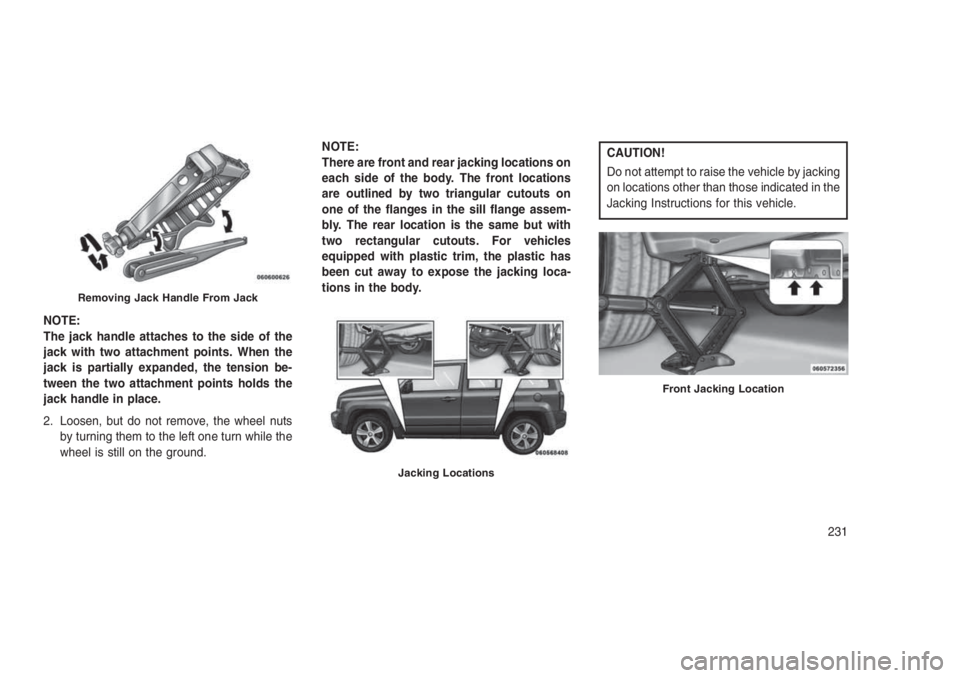
NOTE:
The jack handle attaches to the side of the
jack with two attachment points. When the
jack is partially expanded, the tension be-
tween the two attachment points holds the
jack handle in place.
2. Loosen, but do not remove, the wheel nuts
by turning them to the left one turn while the
wheel is still on the ground.NOTE:
There are front and rear jacking locations on
each side of the body. The front locations
are outlined by two triangular cutouts on
one of the flanges in the sill flange assem-
bly. The rear location is the same but with
two rectangular cutouts. For vehicles
equipped with plastic trim, the plastic has
been cut away to expose the jacking loca-
tions in the body.
CAUTION!
Do not attempt to raise the vehicle by jacking
on locations other than those indicated in the
Jacking Instructions for this vehicle.
Removing Jack Handle From Jack
Jacking Locations
Front Jacking Location
231
Page 236 of 332
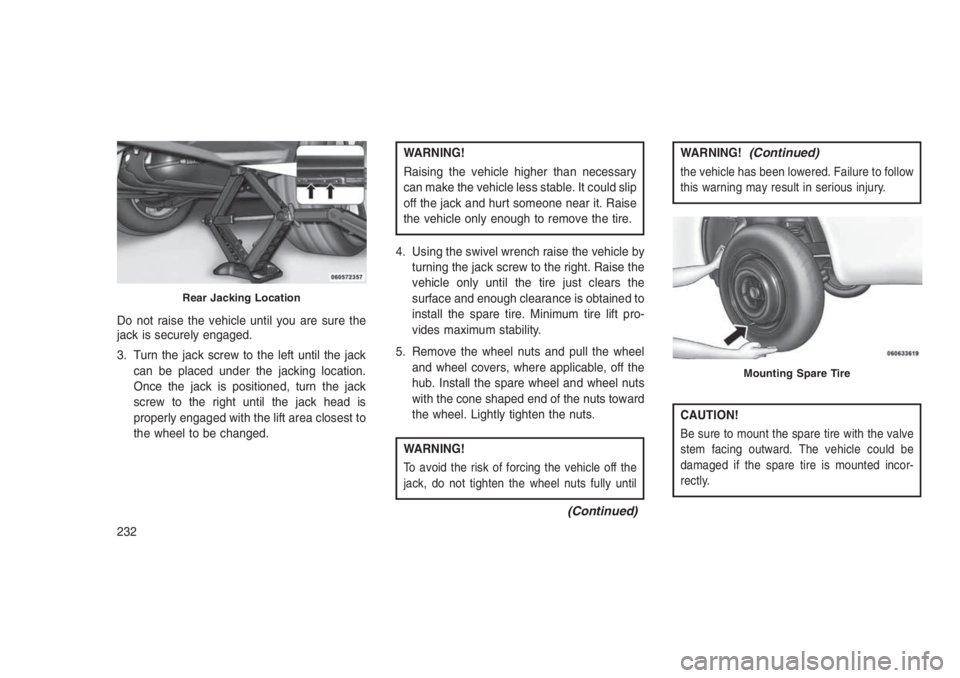
Do not raise the vehicle until you are sure the
jack is securely engaged.
3. Turn the jack screw to the left until the jack
can be placed under the jacking location.
Once the jack is positioned, turn the jack
screw to the right until the jack head is
properly engaged with the lift area closest to
the wheel to be changed.
WARNING!
Raising the vehicle higher than necessary
can make the vehicle less stable. It could slip
off the jack and hurt someone near it. Raise
the vehicle only enough to remove the tire.
4. Using the swivel wrench raise the vehicle by
turning the jack screw to the right. Raise the
vehicle only until the tire just clears the
surface and enough clearance is obtained to
install the spare tire. Minimum tire lift pro-
vides maximum stability.
5. Remove the wheel nuts and pull the wheel
and wheel covers, where applicable, off the
hub. Install the spare wheel and wheel nuts
with the cone shaped end of the nuts toward
the wheel. Lightly tighten the nuts.
WARNING!
To avoid the risk of forcing the vehicle off the
jack, do not tighten the wheel nuts fully until
(Continued)
WARNING!(Continued)
the vehicle has been lowered. Failure to follow
this warning may result in serious injury.
CAUTION!
Be sure to mount the spare tire with the valve
stem facing outward. The vehicle could be
damaged if the spare tire is mounted incor-
rectly.
Rear Jacking Location
Mounting Spare Tire
232
Page 237 of 332
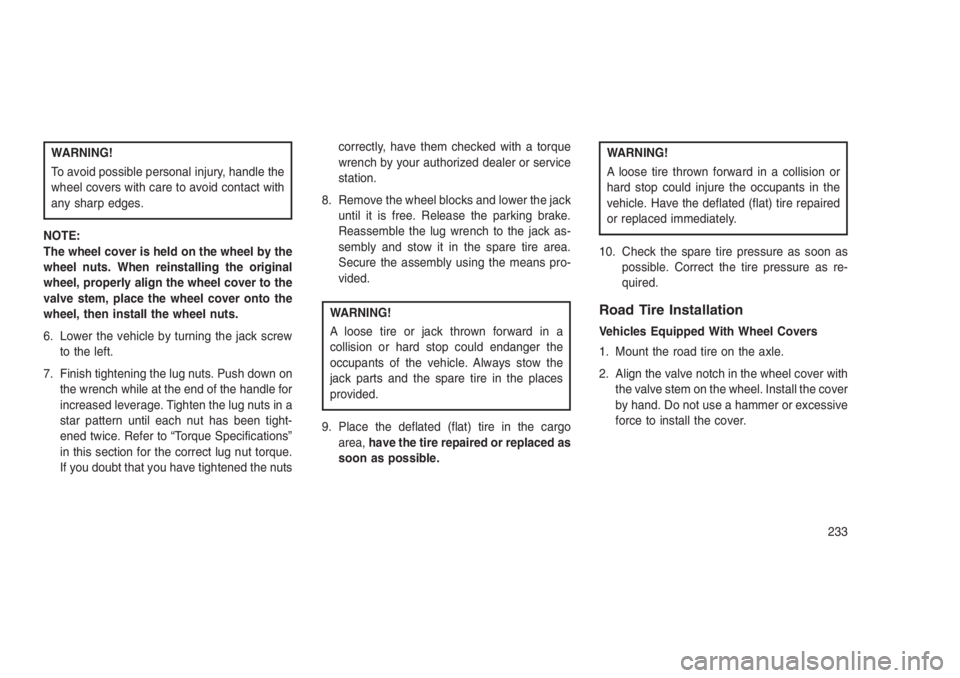
WARNING!
To avoid possible personal injury, handle the
wheel covers with care to avoid contact with
any sharp edges.
NOTE:
The wheel cover is held on the wheel by the
wheel nuts. When reinstalling the original
wheel, properly align the wheel cover to the
valve stem, place the wheel cover onto the
wheel, then install the wheel nuts.
6. Lower the vehicle by turning the jack screw
to the left.
7. Finish tightening the lug nuts. Push down on
the wrench while at the end of the handle for
increased leverage. Tighten the lug nuts in a
star pattern until each nut has been tight-
ened twice. Refer to “Torque Specifications”
in this section for the correct lug nut torque.
If you doubt that you have tightened the nutscorrectly, have them checked with a torque
wrench by your authorized dealer or service
station.
8. Remove the wheel blocks and lower the jack
until it is free. Release the parking brake.
Reassemble the lug wrench to the jack as-
sembly and stow it in the spare tire area.
Secure the assembly using the means pro-
vided.
WARNING!
A loose tire or jack thrown forward in a
collision or hard stop could endanger the
occupants of the vehicle. Always stow the
jack parts and the spare tire in the places
provided.
9. Place the deflated (flat) tire in the cargo
area,have the tire repaired or replaced as
soon as possible.
WARNING!
A loose tire thrown forward in a collision or
hard stop could injure the occupants in the
vehicle. Have the deflated (flat) tire repaired
or replaced immediately.
10. Check the spare tire pressure as soon as
possible. Correct the tire pressure as re-
quired.
Road Tire Installation
Vehicles Equipped With Wheel Covers
1. Mount the road tire on the axle.
2. Align the valve notch in the wheel cover with
the valve stem on the wheel. Install the cover
by hand. Do not use a hammer or excessive
force to install the cover.
233
Page 238 of 332
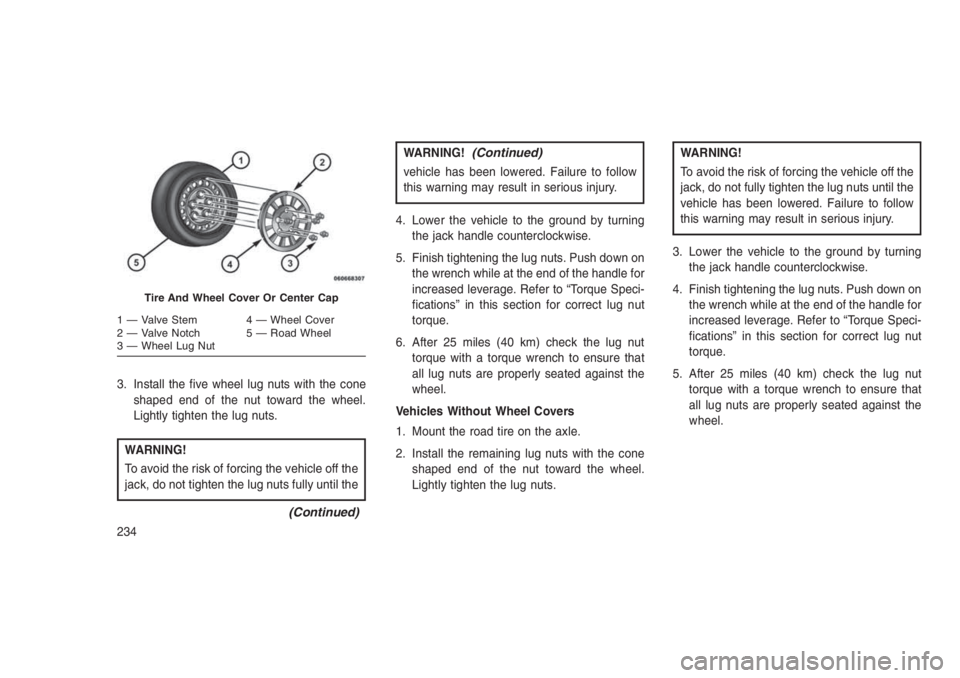
3. Install the five wheel lug nuts with the cone
shaped end of the nut toward the wheel.
Lightly tighten the lug nuts.
WARNING!
To avoid the risk of forcing the vehicle off the
jack, do not tighten the lug nuts fully until the
(Continued)
WARNING!(Continued)
vehicle has been lowered. Failure to follow
this warning may result in serious injury.
4. Lower the vehicle to the ground by turning
the jack handle counterclockwise.
5. Finish tightening the lug nuts. Push down on
the wrench while at the end of the handle for
increased leverage. Refer to “Torque Speci-
fications” in this section for correct lug nut
torque.
6. After 25 miles (40 km) check the lug nut
torque with a torque wrench to ensure that
all lug nuts are properly seated against the
wheel.
Vehicles Without Wheel Covers
1. Mount the road tire on the axle.
2. Install the remaining lug nuts with the cone
shaped end of the nut toward the wheel.
Lightly tighten the lug nuts.
WARNING!
To avoid the risk of forcing the vehicle off the
jack, do not fully tighten the lug nuts until the
vehicle has been lowered. Failure to follow
this warning may result in serious injury.
3. Lower the vehicle to the ground by turning
the jack handle counterclockwise.
4. Finish tightening the lug nuts. Push down on
the wrench while at the end of the handle for
increased leverage. Refer to “Torque Speci-
fications” in this section for correct lug nut
torque.
5. After 25 miles (40 km) check the lug nut
torque with a torque wrench to ensure that
all lug nuts are properly seated against the
wheel.
Tire And Wheel Cover Or Center Cap
1 — Valve Stem 4 — Wheel Cover
2 — Valve Notch 5 — Road Wheel
3 — Wheel Lug Nut
234
Page 239 of 332
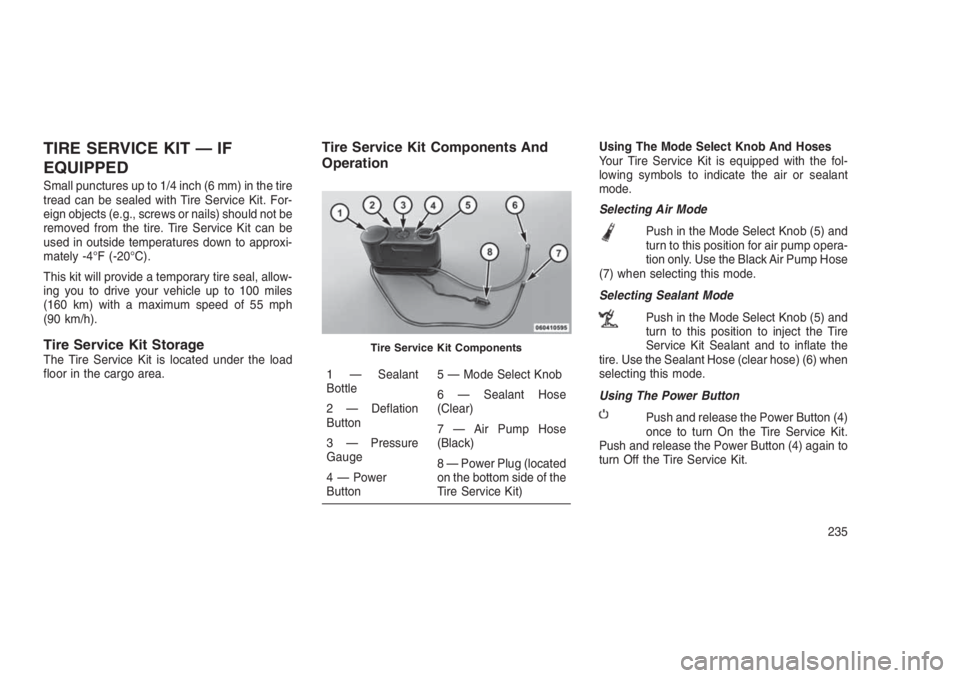
TIRE SERVICE KIT — IF
EQUIPPED
Small punctures up to 1/4 inch (6 mm) in the tire
tread can be sealed with Tire Service Kit. For-
eign objects (e.g., screws or nails) should not be
removed from the tire. Tire Service Kit can be
used in outside temperatures down to approxi-
mately -4°F (-20°C).
This kit will provide a temporary tire seal, allow-
ing you to drive your vehicle up to 100 miles
(160 km) with a maximum speed of 55 mph
(90 km/h).
Tire Service Kit StorageThe Tire Service Kit is located under the load
floor in the cargo area.
Tire Service Kit Components And
OperationUsing The Mode Select Knob And Hoses
Your Tire Service Kit is equipped with the fol-
lowing symbols to indicate the air or sealant
mode.
Selecting Air Mode
Push in the Mode Select Knob (5) and
turn to this position for air pump opera-
tion only. Use the Black Air Pump Hose
(7) when selecting this mode.
Selecting Sealant Mode
Push in the Mode Select Knob (5) and
turn to this position to inject the Tire
Service Kit Sealant and to inflate the
tire. Use the Sealant Hose (clear hose) (6) when
selecting this mode.
Using The Power Button
Push and release the Power Button (4)
once to turn On the Tire Service Kit.
Push and release the Power Button (4) again to
turn Off the Tire Service Kit.
Tire Service Kit Components
1 — Sealant
Bottle5 — Mode Select Knob
2 — Deflation
Button6 — Sealant Hose
(Clear)
3 — Pressure
Gauge7 — Air Pump Hose
(Black)
4 — Power
Button8 — Power Plug (located
on the bottom side of the
Tire Service Kit)
235
Page 240 of 332
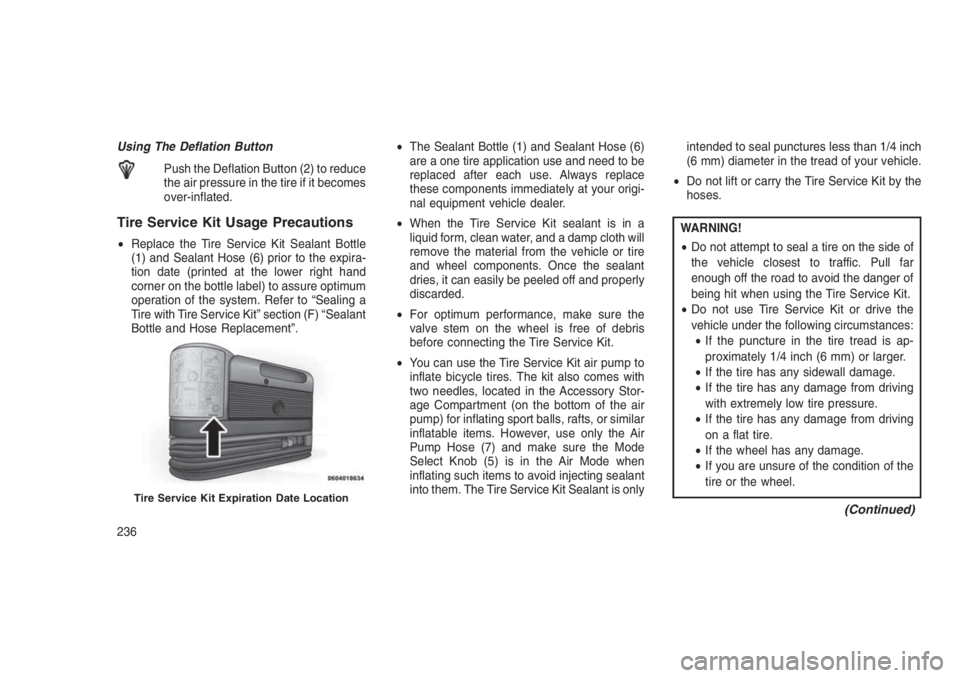
Using The Deflation Button
Push the Deflation Button (2) to reduce
the air pressure in the tire if it becomes
over-inflated.
Tire Service Kit Usage Precautions
•Replace the Tire Service Kit Sealant Bottle
(1) and Sealant Hose (6) prior to the expira-
tion date (printed at the lower right hand
corner on the bottle label) to assure optimum
operation of the system. Refer to “Sealing a
Tire with Tire Service Kit” section (F) “Sealant
Bottle and Hose Replacement”.•The Sealant Bottle (1) and Sealant Hose (6)
are a one tire application use and need to be
replaced after each use. Always replace
these components immediately at your origi-
nal equipment vehicle dealer.
•When the Tire Service Kit sealant is in a
liquid form, clean water, and a damp cloth will
remove the material from the vehicle or tire
and wheel components. Once the sealant
dries, it can easily be peeled off and properly
discarded.
•For optimum performance, make sure the
valve stem on the wheel is free of debris
before connecting the Tire Service Kit.
•You can use the Tire Service Kit air pump to
inflate bicycle tires. The kit also comes with
two needles, located in the Accessory Stor-
age Compartment (on the bottom of the air
pump) for inflating sport balls, rafts, or similar
inflatable items. However, use only the Air
Pump Hose (7) and make sure the Mode
Select Knob (5) is in the Air Mode when
inflating such items to avoid injecting sealant
into them. The Tire Service Kit Sealant is onlyintended to seal punctures less than 1/4 inch
(6 mm) diameter in the tread of your vehicle.
•Do not lift or carry the Tire Service Kit by the
hoses.WARNING!
•Do not attempt to seal a tire on the side of
the vehicle closest to traffic. Pull far
enough off the road to avoid the danger of
being hit when using the Tire Service Kit.
•Do not use Tire Service Kit or drive the
vehicle under the following circumstances:
•If the puncture in the tire tread is ap-
proximately 1/4 inch (6 mm) or larger.
•If the tire has any sidewall damage.
•If the tire has any damage from driving
with extremely low tire pressure.
•If the tire has any damage from driving
on a flat tire.
•If the wheel has any damage.
•If you are unsure of the condition of the
tire or the wheel.
(Continued)Tire Service Kit Expiration Date Location
236